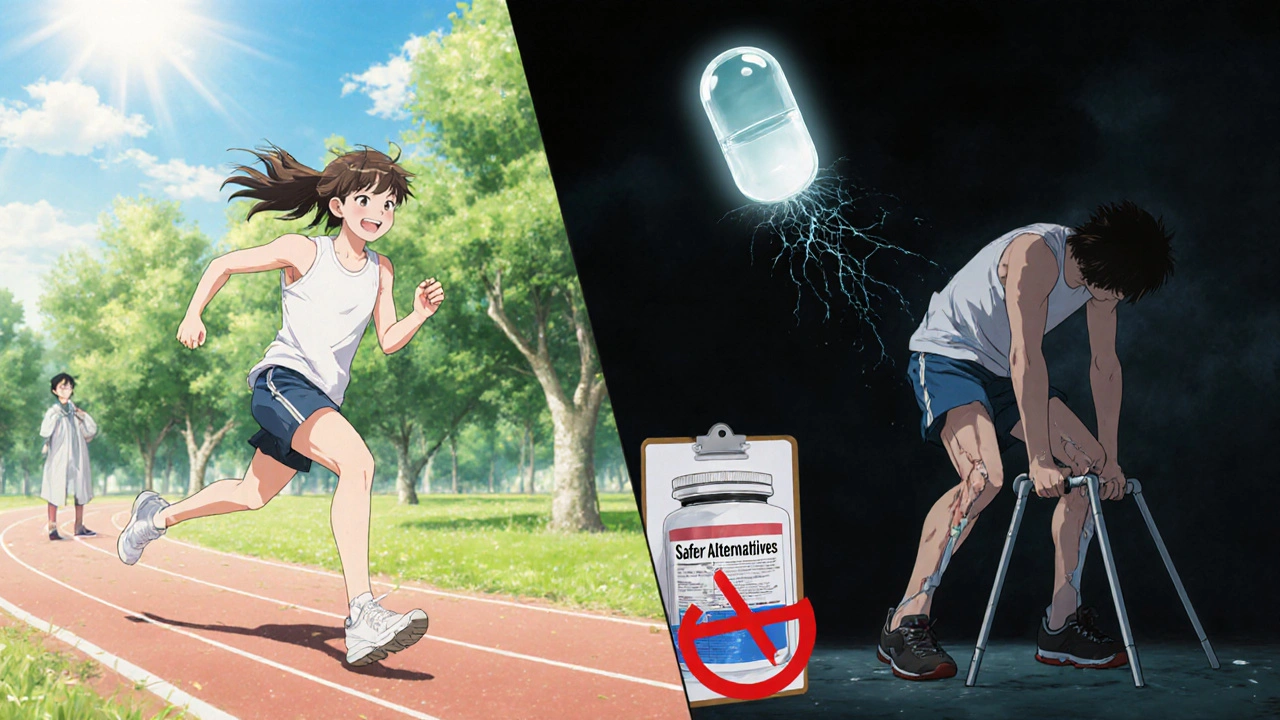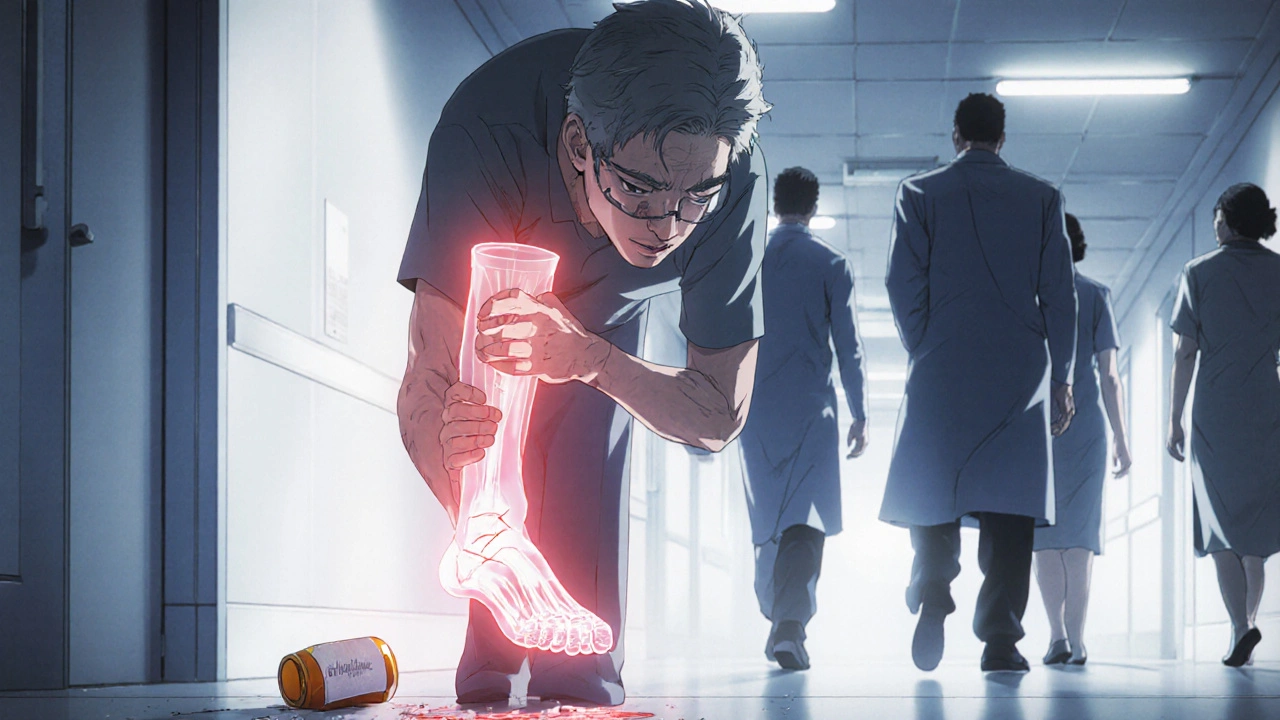When you’re prescribed an antibiotic like ciprofloxacin or levofloxacin, you expect it to clear up your infection. But for some people, these drugs don’t just fight bacteria-they can start damaging tendons and nerves, sometimes with lifelong consequences. This isn’t rare. It’s not just a footnote on the pill bottle. It’s a well-documented, serious risk that’s led regulators in the U.S., Europe, Australia, and New Zealand to severely restrict how and when these antibiotics can be used.
What Are Fluoroquinolones, and Why Are They Still Prescribed?
Fluoroquinolones are a class of powerful antibiotics that include ciprofloxacin, levofloxacin, and moxifloxacin. They work by disrupting bacterial DNA replication, which makes them effective against a wide range of infections-from urinary tract infections to pneumonia. For decades, they were go-to drugs because they’re fast-acting, penetrate tissues well, and cover many types of bacteria.
But here’s the problem: their broad effectiveness came at a hidden cost. By the early 2000s, doctors started noticing patients developing sudden, severe tendon pain. Then came reports of numbness, burning, and tingling in hands and feet-signs of nerve damage. In 2008, the U.S. FDA added a black-box warning to all fluoroquinolones, the strongest type of safety alert. By 2016, after reviewing hundreds of studies, they made it clear: fluoroquinolone side effects like tendon rupture and peripheral neuropathy can be disabling and permanent.
Tendinopathy: More Than Just a Sprain
Fluoroquinolone-induced tendinopathy doesn’t feel like a typical overuse injury. It hits fast. One day you’re fine; the next, your Achilles tendon-located at the back of your ankle-is swollen, tender, and painfully stiff. In 89.8% of cases, it’s the Achilles tendon that’s affected. About 83.7% of patients first experience tendinitis, but in nearly half of those cases, the tendon ruptures completely.
What makes this even more dangerous is timing. Symptoms can appear as early as 2 days after starting the drug-or as late as 152 days after finishing it. Half of all tendon injuries happen after you’ve stopped taking the antibiotic. That means if you’ve finished your 7-day course and suddenly feel a sharp pop in your heel, it could still be linked to the drug you took weeks ago.
Some people are at much higher risk. If you’re over 60, your chance of tendon rupture jumps 2.7 times. If you’re also taking corticosteroids-common for arthritis or asthma-the risk skyrockets by 46 times. Diabetes and kidney disease also increase vulnerability. Even if you’re young and healthy, don’t assume you’re safe. In one study, 50% of tendon injuries affected both sides at once.
Nerve Damage: The Silent Threat
Peripheral neuropathy is another major concern. It’s not just a side effect-it’s a neurological injury. Patients describe it as burning, electric shocks, numbness, or a feeling of wearing socks when they’re barefoot. This isn’t temporary tingling. In 4.3% of patients, it’s confirmed through nerve testing. And in up to 10% of those affected, the damage doesn’t go away.
Onset is usually within the first month of treatment, but like tendon damage, it can creep in later. Many patients report their symptoms were dismissed by doctors as “aging,” “stress,” or “carpal tunnel.” One patient in the Fluoroquinolone Effects Research Foundation database said her symptoms started 11 weeks after finishing levofloxacin for a sinus infection. Her neurologist didn’t connect the dots until she brought up the antibiotic herself.
There’s no cure. Stopping the drug helps, but nerve damage often persists. Some patients need pain medications for years. Others lose balance, grip strength, or the ability to walk normally.

Who Should Never Take These Antibiotics?
Regulators now say fluoroquinolones should only be used when no other option exists. That means:
- Don’t use them for simple urinary tract infections-there are safer alternatives like nitrofurantoin or fosfomycin.
- Avoid them for acute sinusitis, bronchitis, or mild skin infections.
- Never use them for viral infections like colds or flu.
In New Zealand, Medsafe requires doctors to warn patients about the risk of long-term tendon and nerve damage before prescribing. In the UK, the MHRA says these drugs are off-limits for mild infections. In the U.S., the FDA says they’re reserved for life-threatening conditions like anthrax, complicated pneumonia, or hospital-acquired infections.
Even then, the risk remains. A 2023 study found that 62% of current fluoroquinolone prescriptions are for complicated UTIs, 23% for pneumonia, and just 2.4% for inappropriate uses like bronchitis. That’s progress-but it’s not enough.
What Happens After the Damage Is Done?
Recovery is slow, uncertain, and often incomplete. For tendon injuries, most patients are treated without surgery-but recovery takes a median of one month, and up to 35% of severe cases require surgical repair. Some patients report pain lasting 2 to 5 years. One Reddit user described bilateral Achilles ruptures after just 7 days of levofloxacin. It took him 11 months to walk without crutches.
Nerve damage is even harder to reverse. Physical therapy, pain management, and supplements like alpha-lipoic acid are often tried, but evidence is limited. In the Fluoroquinolone Effects Research Foundation’s database of over 8,500 patients, 78% reported tendon issues, and 68% of negative drug reviews on Drugs.com mentioned nerve or tendon damage.
What’s worse? Many patients say their doctors didn’t know the risks. A 2022 study found only 43% of primary care physicians could correctly identify fluoroquinolone-induced tendinopathy in a case scenario. That means if you develop symptoms, you might be told it’s “just aging” or “overuse”-and lose precious time.

What Should You Do If You’re Prescribed One?
If your doctor suggests a fluoroquinolone, ask:
- Is this infection serious enough to justify this drug?
- Are there safer alternatives?
- What are the signs of tendon or nerve damage I should watch for?
If you’re already taking one and notice:
- Sudden pain, swelling, or stiffness in a tendon (especially the Achilles)
- Numbness, tingling, burning, or weakness in your hands or feet
Stop the drug immediately and call your doctor. Don’t wait. Don’t assume it’s minor. Discontinuing the antibiotic at the first sign can prevent full rupture or permanent nerve injury.
Avoid corticosteroids entirely if you’ve taken a fluoroquinolone-even a topical cream or nasal spray. The combination is a known recipe for disaster.
The Bigger Picture: Why This Matters
The global market for fluoroquinolones has dropped 27% since 2015. Prescribing for simple infections has fallen from 17% to under 5% in the U.S. That’s because doctors are learning. Regulators are enforcing. Patients are speaking up.
But the damage has already been done. Thousands have been left with chronic pain, mobility issues, and neurological problems. Many never knew the risk until it was too late.
These antibiotics aren’t evil. They save lives in severe, resistant infections. But for most common conditions, the risks far outweigh the benefits. The question isn’t whether they work-it’s whether the cost is worth it.
If you’ve been prescribed one, don’t accept it without questions. If you’ve already taken one and feel off-listen to your body. You’re not imagining it. And you’re not alone.
Can fluoroquinolone tendon damage be reversed?
In some cases, yes-if caught early and the drug is stopped immediately. But many patients experience lasting damage. Up to 10% report chronic pain, reduced mobility, or inability to return to normal activity. Tendon ruptures often require surgery and months of rehab. Nerve damage is even less likely to fully resolve.
How soon after taking fluoroquinolones do side effects start?
Symptoms can appear as early as 2 days after starting the drug, but most occur within the first month. Alarmingly, half of tendon injuries happen after you’ve finished the course-sometimes weeks or even months later. Nerve damage usually starts within 30 days, but delayed onset is well documented.
Are all fluoroquinolones equally risky?
Ciprofloxacin is the most commonly reported cause of tendon damage, followed by levofloxacin and norfloxacin. But all fluoroquinolones carry the same black-box warnings. No one is considered safer than another for these specific risks. The class as a whole is linked to tendinopathy and neuropathy.
What should I do if I think I’m having side effects?
Stop taking the medication immediately. Contact your doctor and mention you suspect fluoroquinolone-induced tendon or nerve damage. Avoid corticosteroids, strenuous activity, and heat on the affected area. Request an ultrasound or MRI if tendon damage is suspected. For nerve symptoms, ask for nerve conduction studies. Document everything-this is critical for diagnosis and future care.
Are there safer antibiotics for common infections?
Yes. For urinary tract infections, nitrofurantoin, fosfomycin, or trimethoprim-sulfamethoxazole are preferred. For sinus infections, amoxicillin or doxycycline are first-line. For bronchitis, most cases don’t need antibiotics at all. For skin infections, cephalexin or clindamycin are safer options. Always ask your doctor if a fluoroquinolone is truly necessary.

